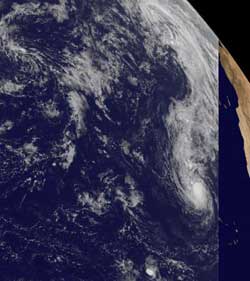GOES-13 Satellite sees Lisa a tropical storm…for now

The GOES-13 satellite captured a visible image of Tropical Storm Lisa (right) at 16 45 UTC (12:45 p.m. EDT) on Sept. 24. The GOES visible imagery showed that Lisa now has a well-organized center of circulation. Credit: NOAA/NASA GOES Project<br>
At 11 a.m. EDT on Friday, Sept. 24, Tropical Storm Lisa had maximum sustained winds near 50 mph and she may strengthen and weaken over the weekend, but by Sunday colder waters will zap her energy source and she is forecast to be a depression.
Meanwhile, on Sept. 24, she was still frolicking in the eastern Atlantic, about 320 miles northwest of the Cape Verde Islands, near 18.9 North latitude and 27.8 West longitude. Lisa was moving north at 7 mph and is expected to turn north-northwest on Sept. 25. Estimated minimum central pressure is 1000 millibars.
The GOES-13 satellite captured a visible image of Tropical Storm Lisa at 16 45 UTC (12:45 p.m. EDT) on Sept. 24. The GOES visible imagery showed that Lisa now has a well-organized center of circulation, which corresponds with infrared and microwave satellite imagery that showed convection has wrapped around three-fourths of the center of circulation.
The infrared data from the Atmospheric Infrared Sounder (AIRS) instrument on NASA's Aqua satellite today showed that Lisa's thunderstorm cloud tops, north of the center of circulation had cooled down to a frosty -80 Celsius (-112 Fahrenheit), one factor that confirms her re-strengthening. The colder the cloud top temperatures, the higher the thunderstorms, and the more powerful they are. When cloud top temperatures cool, it indicates a strengthening storm. When they warm, a storm is weakening.
Over the weekend, Lisa will move into colder waters and the westerly wind shear will increase ahead of an elongated are of low pressure. The wind shear is forecast to be moderate to strong. So strong that they're expected to “decouple” or separate the low-level circulation from the upper-level circulation in the storm causing it to weaken significantly.
Lisa is expected to become a remnant low pressure system by early next week in the eastern Atlantic.
Media Contact
More Information:
http://www.nasa.govAll latest news from the category: Earth Sciences
Earth Sciences (also referred to as Geosciences), which deals with basic issues surrounding our planet, plays a vital role in the area of energy and raw materials supply.
Earth Sciences comprises subjects such as geology, geography, geological informatics, paleontology, mineralogy, petrography, crystallography, geophysics, geodesy, glaciology, cartography, photogrammetry, meteorology and seismology, early-warning systems, earthquake research and polar research.
Newest articles

High-energy-density aqueous battery based on halogen multi-electron transfer
Traditional non-aqueous lithium-ion batteries have a high energy density, but their safety is compromised due to the flammable organic electrolytes they utilize. Aqueous batteries use water as the solvent for…

First-ever combined heart pump and pig kidney transplant
…gives new hope to patient with terminal illness. Surgeons at NYU Langone Health performed the first-ever combined mechanical heart pump and gene-edited pig kidney transplant surgery in a 54-year-old woman…

Biophysics: Testing how well biomarkers work
LMU researchers have developed a method to determine how reliably target proteins can be labeled using super-resolution fluorescence microscopy. Modern microscopy techniques make it possible to examine the inner workings…





















